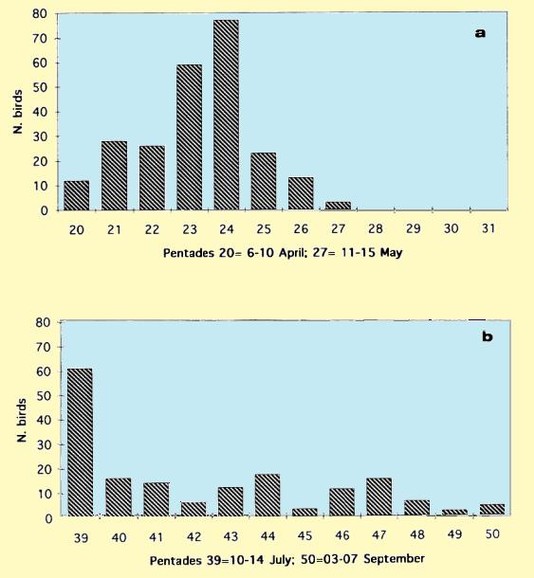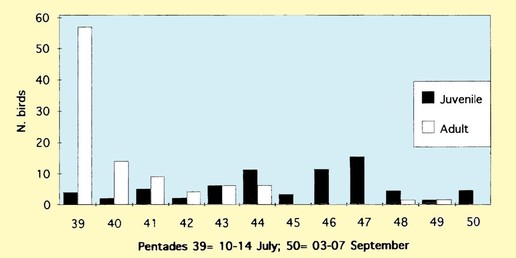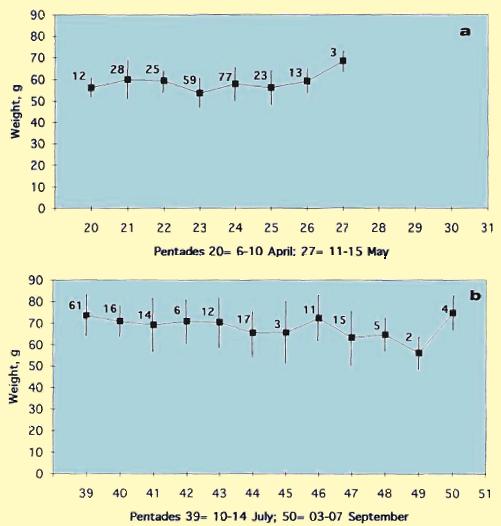Tringa glareola - Gruppo Inanellamento Limicoli (GIL, Napoli)
Menu principale:
- Home Page
- L'Associazione
-
Ricerche in atto
- Migrazione autunnale Allodola
- Migrazione primaverile Tordo
- Ali Tordo bottaccio in Campania
- Stazione Monte Vaccaro
- Riserva Naturale Foce Volturno
- Inanellamento Medio Volturno
- Avifauna svernante
- Avifauna Foce Neto e Sila
-
Ricerche concluse
- Ali Turdidi e Beccacce ATC LT 2
- Stazione Malga Rosello
- Migrazione Caradriiformi
- Progetto Rondine
- Migrazione autunnale Tordo
- Ali Turdidi e Beccacce ATC CE
- Progetto Alauda 2000
- Osservatorio Roccolo Ganda
- Atlante Migrazioni Puglia
- Download
- News
Tringa glareola
Migration pattern and weight changes of Wood Sandpiper Tringa glareola in a stopover site in southern Italy
Sergio Scebba & Giancarlo Moschetti
from: Ringing and Migration (1996) 17: 101-
SUMMARY
408 Wood Sandpipers were examined at a stopover site in the central Mediterranean near the southern Italian coast during the pre-
INTRODUCTION
The Wood Sandpiper Tringa glareola is a common migrant in Campania (south Italy) but its migration dynamics and weight changes are undescribed. Little is known about the utilization of food resources and the changes in body mass during periods at stopover sites.
Birds ringed within breeding range in Fenno-
In this paper we describe the studies that have been carried out on migrant Wood Sandpipers and their mass changes in a stopover area in southern Italy.
STUDY SITE & METHODS
The work was carried out at four sites in the Volturno plain (Caserta). One was situated near the mouth of the river Volturno, another near the inflow of a channel of waste water; the other two were small artificial ponds used as decoys for hunting ducks. Birds were ringed in the spring of 1992 and 1993 and in the summer of 1991 and 1992; in total, 408 Wood Sandpipers were ringed during pre-
Trapping was carried out twice-
The samples from the three years were pooled and fitted into standard 5-
RESULTS AND DISCUSSION
Migration patterns
In spring, birds were caught between 8 April to 13 May (pentades 20-

Fig. 1. Trapping patterns per pentades of Wood Sandpipers on the Volturno plain during (a) pre-
Age class distribution in summer showed that adult movements begin early July, while juvenile movements begin early August (Fig. 2). Similar patterns were reported by Cramp & Simmons (1983).

Fig. 2. Age class distribution of Wood Sandpipers during post-
Analysis of body mass
The variation in body mass per pentades is shown in Figs. 3a (spring) and 3b (summer). Mean body mass of birds ringed in spring was 57.2 g (SD = 7.2, n=240), ranging between 42.5 g and 81.0 g. In summer the mean was 70.3 g (SD = 10.6, n=166, min 46.0 g, max 94.0 g). The difference between the means is statistically significant (t-

Fig. 3. Variation in body mass per pentades of Wood Sandpipers trapped during (a) spring 1992 and 1993, pentades 20= 6-
In spring, the frequency distribution of body mass showed a bimodal distribution with a peak at 50 g and another one at 60 g (Fig. 4a). Even in summer the distribution was bimodal with a peak at 64 g and another one at 76 g (Fig. 4b). These patterns could be due to two age classes. In fact, in summer adult body mass was higher than in juveniles: mean adult body mass was 72.5 g (SD = 9.3, n=98), vs. the juvenile mean of 66.9 g (SD = 11.5, n=68). The difference between the means is statistically significant (t-
Body mass variation of retrapped birds
Only 6 birds out of 408 which were ringed between 1991-
On the basis of the days which elapsed between ringing and recapture during post-
CONCLUSION
An examination of body mass of Wood Sandpipers at two different Mediterranean stopover sites during their pre-
In this season the level of brackish water in the artificial ponds was sufficiently constant; it allowed the presence of numerous Crustacea (ex. Gammarus
During summer migration, Glutz et al.
In summer, mean body mass of juveniles and adults was significantly different and individuals weighed more than once during the same refuelling stop have show a significant mass increase. Our results indicated that a considerable number of Wood Sandpipers stop over on the Volturno plain during their northward spring migration and that summer migrating birds use the artificial ponds both as a resting area and as a refuelling site to accumulate fat.
ACKNOWLEDGEMENTS
The following people helped with field work: Rodney West, Paul Newton, Michael Wright, John Glazebrook and Alan Miller of Wader Study Group, Phil Ireland of Wash Wader Ringing Group, Zsolt Karcza of Hungarian Ornithological Society, Andrea Vitolo, Marta Lancini, Rosanna Esposito and Stefano Laurenti of Gruppo Inanellamento Limicoli (Naples), Roy Hughes and Jan Spence. We would like to thank Gabor Lövei for reading and criticising the manuscript and Mark Walters for the stylistic amendments. We are pleased to acknowledge Daniele Anesa and "Roccolo Ganda" Bird Observatory (Aviatico-
REFERENCES
Akriotis, T. (1991) Weight changes in the Wood Sandpiper Tringa glareola in south-
Berthold, P. (1973) Proposals for the standardization of the presentation of annual events, especially of migrating data. Auspicium
Cramp, S. & Simmons, K.E.L. (1983) The Handbook of the Birds of the Western Palearctic.
Glutz von Blotzheim, U.N., Bauer, K.M. & Bezzel, E. (1977) Handbuch der Voegel Mitteleuropas. Vol. 7. Akademische. Verlagsgellsschaft, Wiesbaden.
Iapichino, C. & Massa, B. (1989) The Birds of Sicily. British Ornithologist's Union.
Prater, A.J., Marchant, J.H. & Vuorinen, J. (1977) Guide to identification and ageing of Holarctic waders. B.T.O. Guide 17, Tring.
Scebba, S. (1993) Gli Uccelli della Campania. Ed. Esselibri, Napoli.
Paper n.18 of Gruppo Inanellamento Limicoli (G.I.L.), Naples-